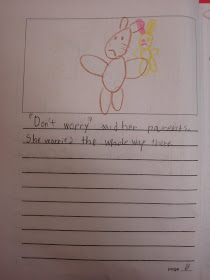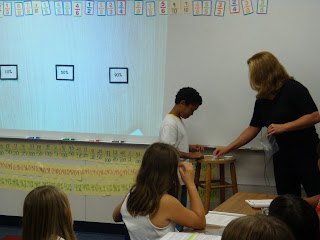 Like so many children, my seven year old, first grader, sat down to create his Christmas list this week. He didn't have any trouble coming up with ideas, as you can tell when you click on the picture and zoom in on his writing. He wrote feverishly for about 15 minutes to write the front page early in the week, and then this morning, he sat and reread his list. After rereading, he flipped his paper over and wrote feverishly for another 15 minutes. He presented his paper to me with a big grin and high hopes. I laughed out loud as I read each item. I could have stopped there, but the teacher in me wouldn't allow it, so here I sit creating a post to answer the question-- What can a Christmas list tell you about your child's education?
Like so many children, my seven year old, first grader, sat down to create his Christmas list this week. He didn't have any trouble coming up with ideas, as you can tell when you click on the picture and zoom in on his writing. He wrote feverishly for about 15 minutes to write the front page early in the week, and then this morning, he sat and reread his list. After rereading, he flipped his paper over and wrote feverishly for another 15 minutes. He presented his paper to me with a big grin and high hopes. I laughed out loud as I read each item. I could have stopped there, but the teacher in me wouldn't allow it, so here I sit creating a post to answer the question-- What can a Christmas list tell you about your child's education? Here goes...
1) He's been taught to THINK BIG, the sky is the limit and he will reach it, all things are possible. Do you notice that he put on his list a laptop computer, baby  brother/sister, female toy "yourkey" dog? And, that even though he has a PS 2, Wii, and PSP, he still adds another gaming system--the XBOX 360. (Maybe that should be my clue that I should examine the word...spoiled.)
brother/sister, female toy "yourkey" dog? And, that even though he has a PS 2, Wii, and PSP, he still adds another gaming system--the XBOX 360. (Maybe that should be my clue that I should examine the word...spoiled.)
 brother/sister, female toy "yourkey" dog? And, that even though he has a PS 2, Wii, and PSP, he still adds another gaming system--the XBOX 360. (Maybe that should be my clue that I should examine the word...spoiled.)
brother/sister, female toy "yourkey" dog? And, that even though he has a PS 2, Wii, and PSP, he still adds another gaming system--the XBOX 360. (Maybe that should be my clue that I should examine the word...spoiled.) 2) He's been taught to WRITE FLUENTLY, hence two pages in about half an hour. He doesn't hesitate to pick up a pencil and write independently, and share his writing with others. He's been taught that writing is a way to express yourself and sell your ideas to others. He's also been taught to reread his writing and add to it. Lucky me that he came up with page two. How will I chose which hopes I dash?
3) He's been taught to SPELL, and writes almost all high frequency words correctly, and those that are not high frequency words, he spells following phonetic rules. He also spells higher level words correctly. Notice that alien, force, suit, computer, memory, clone, life sized, light, female, world, picture frame, book mark, brother, sister, and motorcycle are all spelled correctly. And, notice that you can still read his misspelled words-machen, sighn, ultmate, sliipers, gersey, glassess, and hellmet. I find it extremely sweet that he spells words from his studies this year correctly like Australia. I guess it is time that I taught him how to spell his middle name, since he spelled it incorrectly on his paper--Christtopher. :) He's even taken a good stab at the proper nouns. He spelled Rothlisberger, a football player, "Roflessburger," and Polamalu, another player, "Pulomulu," not a bad attempt.
More importantly,
4) He's been taught to love learning. Thank you to Maria and Cheryl. He's added world map and a world ball to his list because they've turned him on to geography. He's constantly looking for countries they mention in their classroom. He's added books to his list including "The Mixed-up Chamilyon" by Eric Carle and a book mark.
4) He's been taught to love learning. Thank you to Maria and Cheryl. He's added world map and a world ball to his list because they've turned him on to geography. He's constantly looking for countries they mention in their classroom. He's added books to his list including "The Mixed-up Chamilyon" by Eric Carle and a book mark.
Your child's Christmas list can teach you a lot about your child's education and I'm so glad I took a few minutes to reflect on my child's list.

































